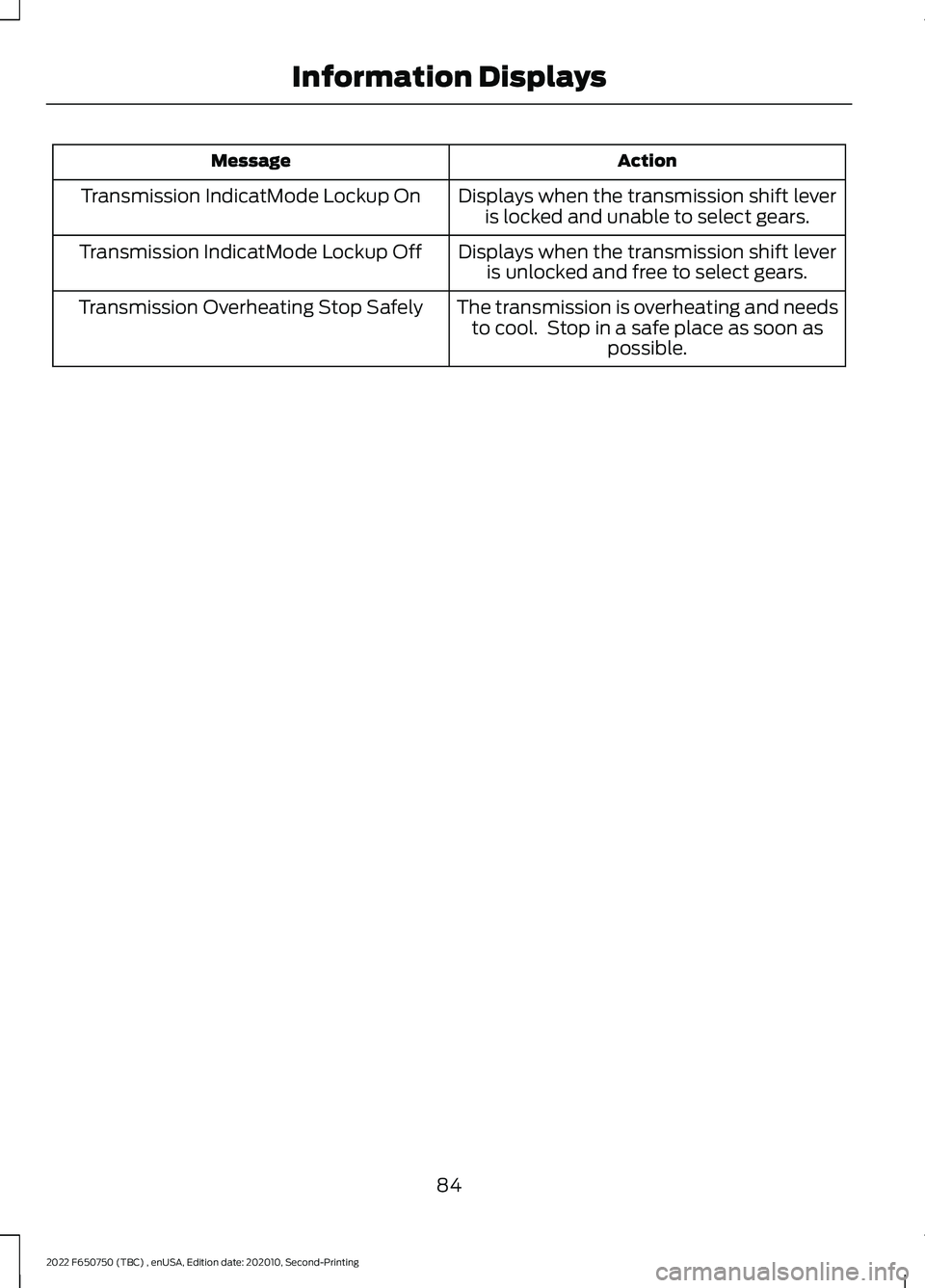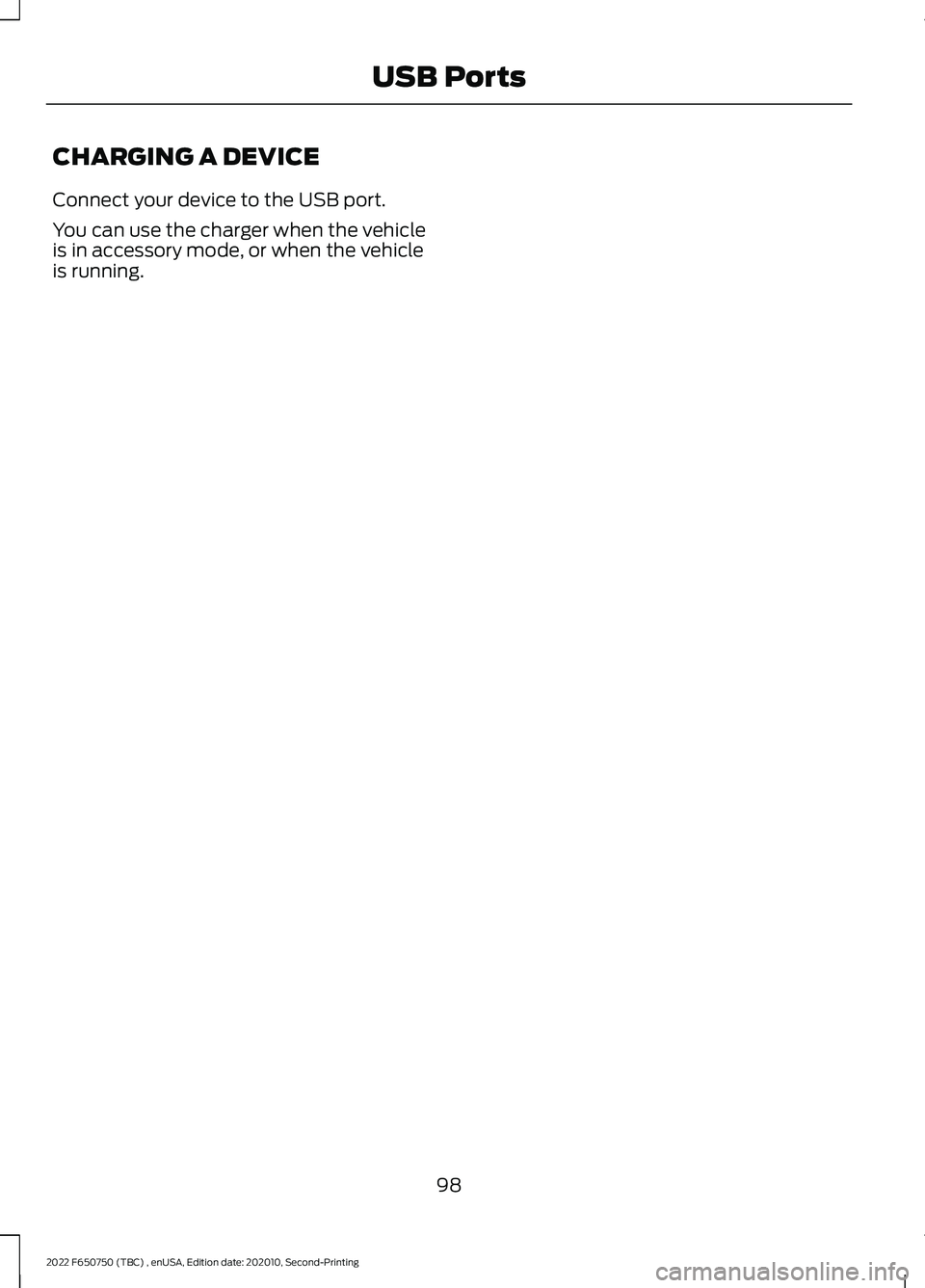2022 FORD F-650/750 ECO mode
[x] Cancel search: ECO modePage 81 of 379

Action
Message
The diesel exhaust fluid is nearing empty.Your vehicle's top speed will become
limited in the displayed distance. You must
replenish the diesel exhaust fluid to resume normal operation of your vehicle. See
Selective Catalytic Reductant System (page 118).
DEF Level Empty Speed Limited to avg
speed imperial:#0 MPH in distance imperial:###0 mi
DEF Level Empty Speed Limited to avg speed metric:#0 km/h in distance metric:###0 km
The remaining diesel exhaust fluid has
depleted. Upon restart, your vehicle speed is now limited. You must replenish thediesel exhaust fluid to resume normal
operation of your vehicle. See
Selective
Catalytic Reductant System (page 118).
DEF Level Empty Speed Limited to avg
speed imperial:#0 MPH Upon Restart
DEF Level Empty Speed Limited to avg speed metric:#0 km/h Upon Restart
The diesel exhaust fluid is empty. You must
replenish the diesel exhaust fluid to resumenormal operation of your vehicle. See
Selective Catalytic Reductant System (page
118).
DEF Level Empty Speed Limited to avg
speed imperial:#0 MPH
DEF Level Empty Speed Limited to avg speed metric:#0 km/h
The selective catalytic reduction system
detects low exhaust fluid. The engine will
eventually enter into an idle only mode. You must replenish diesel exhaust fluid to
resume normal operation of your vehicle. See
Selective Catalytic Reductant System (page 118).
DEF Level Empty Engine Idled Soon
The selective catalytic reduction requires
service and is causing your vehicle to enter an idle-only mode. If the exhaust fluid is empty, you must replenish the diesel
exhaust fluid to resume normal operation of your vehicle. See
Selective Catalytic
Reductant System (page 118).
DEF Level Empty Engine Idled See Manual
The selective catalytic reduction system
requires service. The system displays your vehicle's top speed limit and distance
before limitation. Have the system checked as soon as possible.
DEF Fault Speed Limited to avg speed
imperial:#0 MPH in distance imperial:###0 mi
DEF Fault Speed Limited to avg speed
metric:#0 km/h in distance metric:###0 km
78
2022 F650750 (TBC) , enUSA, Edition date: 202010, Second-Printing Information Displays
Page 84 of 379

Lane Departure Warning System
Action
Message
The system has detected a condition thathas caused the system to be temporarilyunavailable. If the message continues to
display, have the system checked as soon as possible.
Front Camera Temporarily Not Available
The system has detected a condition that
requires you to clean the windshield in order for it to operate properly.
Front Camera Low Visibility Clean Screen
The system requires service, have thesystem checked as soon as possible.
Front Camera Malfunction Service Required
The system requests you to keep yourhands on the steering wheel.
Keep Hands on Steering Wheel
Maintenance Action
Message
Stop your vehicle as soon as safely possible
and turn off the engine. Check the oil level,
if the warning stays on or continues to comeon with your engine running, have yourvehicle checked as soon as possible.
Low Engine Oil Pressure
The engine oil life is low and needs to bechanged soon.
Change Engine Oil Soon
The engine oil life is low and needs to bechanged immediately.
Oil Change Required
The brake fluid level is low, have the systemchecked as soon as possible.
Brake Fluid Level Low
The brake system requires service. Stopyour vehicle in a safe place. Have thesystem checked as soon as possible.
Check Brake System
Your vehicle is still in transport or factory
mode. This may not allow some features to operate properly. Have your vehicle checked as soon as possible.
Factory Mode Contact Dealer
Transport Mode Contact Dealer
The powertrain requires service.
See Manual
81
2022 F650750 (TBC) , enUSA, Edition date: 202010, Second-Printing Information Displays
Page 86 of 379

Transmission
Action
Message
You switched the engine off and the shift
selector is in any position other than park (P).
Shift to Park
Displays when the brake pedal needs to bepressed.
Press Brake Pedal
The transmission is overheating and needsto cool. Stop in a safe place as soon as possible.
Transmission Over Temperature Stop
Safely
Have the system checked as soon aspossible.
Transmission Service Required
The transmission is overheating and needsto cool. Stop in a safe place as soon as possible.
Transmission Too Hot Press Brake
The transmission has limited functionality.Have the system checked as soon as possible.
Transmission Limited Function See Manual
A reminder to shift into park (P). In addi-tion, this message is typical after recon-
necting or recharging the battery until you cycle the ignition to the on mode. See
Changing the 12V Battery (page 245).
Transmission Not in Park
Have the system checked as soon aspossible.
Transmission Fault Service Now
Displays when the transmission hasadjusted the shift strategy.
Transmission Adjusted
Displays when the transmission is adjustingthe shift strategy.
Transmission AdaptMode
Transmission is too cold. Wait for it to warmup before you drive.
Transmission Warming Up Please Wait
83
2022 F650750 (TBC) , enUSA, Edition date: 202010, Second-Printing Information Displays
Page 87 of 379

Action
Message
Displays when the transmission shift leveris locked and unable to select gears.
Transmission IndicatMode Lockup On
Displays when the transmission shift leveris unlocked and free to select gears.
Transmission IndicatMode Lockup Off
The transmission is overheating and needsto cool. Stop in a safe place as soon as possible.
Transmission Overheating Stop Safely
84
2022 F650750 (TBC) , enUSA, Edition date: 202010, Second-Printing Information Displays
Page 89 of 379

Air directed to the instrument panel and
footwell air vents turns off. You can also
use this setting to defog and clear the
windshield of a thin covering of ice.
Switching Maximum Air
Conditioning On and Off
Press and release the button for
maximum cooling.
The left-hand and right-hand settings set
to LO, recirculated air flows through the
instrument panel air vents, air conditioning
turns on and the blower motor adjusts to
the highest speed.
Switching Recirculated Air On and
Off Press and release the button to
switch between outside air and
recirculated air.
The air currently in the passenger
compartment recirculates. This may
reduce the time needed to cool the interior
(when used with A/C) and reduce
unwanted odors from entering your vehicle.
Note: Recirculated air may turn off (or
prevent you from switching on) in all air flow
modes except MAX A/C to reduce the risk
of fogging. Recirculation may also turn on
and off in various air distribution control
combinations during hot weather in order
to improve cooling efficiency.
HINTS ON CONTROLLING THE
INTERIOR CLIMATE
General Hints
Note: Prolonged use of recirculated air may
cause the windows to fog up.
Note: You may feel a small amount of air
from the footwell air vents regardless of the
air distribution setting. Note:
To reduce humidity build-up inside
your vehicle, do not drive with the system
switched off or with recirculated air always
switched on.
Note: Do not place objects under the front
seats as this may interfere with the airflow
to the rear seats.
Note: Remove any snow, ice or leaves from
the air intake area at the base of the
windshield.
Note: To improve the time to reach a
comfortable temperature in hot weather,
drive with the windows open until you feel
cold air through the air vents.
Quickly Heating the Interior
1. Adjust the blower motor speed to the highest speed setting.
2. Adjust the temperature control to the highest setting.
3. Direct air to the footwell air vents.
Recommended Settings for
Heating
1. Adjust the blower motor speed to the center setting.
2. Adjust the temperature control to the midway point of the hot settings.
3. Direct air to the footwell air vents.
Quickly Cooling the Interior
1. Select MAX A/C.
2. Drive with the windows open for a short
period of time.
Recommended Settings for
Cooling
1. Adjust the blower motor speed to the center setting.
2. Adjust the temperature control to the midway point of the cold settings.
86
2022 F650750 (TBC) , enUSA, Edition date: 202010, Second-Printing Climate Control
Page 99 of 379

When the indicator light on the power point
is:
•
On: The power point is working, the
ignition is on and a device is plugged
in.
• Off: The power point is off, the ignition
is off or no device is plugged in.
• Flashing: The power point is in fault
mode.
The power outlet temporarily turns off
power when in fault mode if the device
exceeds the 150 watt limit. Unplug your
device and switch the ignition off. Switch
the ignition back on, but do not plug your
device back in. Let the system cool off and
switch the ignition off to reset the fault
mode. Switch the ignition back on and
make sure the indicator light remains on.
Do not use the power point for certain
electric devices, including:
• Cathode-ray, tube-type televisions.
• Motor loads, such as vacuum cleaners,
electric saws and other electric power
tools or compressor-driven
refrigerators.
• Measuring devices, which process
precise data, such as medical
equipment or measuring equipment.
• Other appliances requiring an
extremely stable power supply such as
microcomputer-controlled electric
blankets or touch-sensor lamps.
96
2022 F650750 (TBC) , enUSA, Edition date: 202010, Second-Printing Auxiliary Power Points
Page 101 of 379

CHARGING A DEVICE
Connect your device to the USB port.
You can use the charger when the vehicle
is in accessory mode, or when the vehicle
is running.
98
2022 F650750 (TBC) , enUSA, Edition date: 202010, Second-Printing USB Ports
Page 107 of 379

The engine idle shutdown timer does not
start if:
•
The engine is operating in battery
charge protect or power take-off mode.
• The exhaust emission control device is
regenerating.
ENGINE BLOCK HEATER (IF
EQUIPPED) WARNING:
Failure to follow engine
block heater instructions could result in
property damage or serious personal
injury. WARNING: Do not use your heater
with ungrounded electrical systems or
two-pronged adapters. There is a risk of
electrical shock.
Note: The heater is most effective when
outdoor temperatures are below
0°F
(-18°C).
The heater acts as a starting aid by
warming the engine coolant. This allows
the climate control system to respond
quickly. The equipment includes a heater
element (installed in the engine block) and
a wire harness. You can connect the
system to a grounded 120-volt AC
electrical source.
We recommend that you do the following
for a safe and correct operation:
• Use a 16-gauge outdoor extension cord
that is product certified by
Underwriter ’s Laboratory (UL) or
Canadian Standards Association
(CSA). This extension cord must be
suitable for use outdoors, in cold temperatures, and be clearly marked
Suitable for Use with Outdoor
Appliances. Do not use an indoor
extension cord outdoors. This could
result in an electric shock or become a
fire hazard.
• Use as short an extension cord as
possible.
• Do not use multiple extension cords.
• Make sure that when in operation, the
extension cord plug and heater cord
plug connections are free and clear of
water. This could cause an electric
shock or fire.
• Make sure your vehicle is parked in a
clean area, clear of combustibles.
• Make sure the heater, heater cord and
extension cord are firmly connected.
• Check for heat anywhere in the
electrical hookup once the system has
been operating for approximately 30
minutes.
• Make sure the system is unplugged and
properly stowed before starting and
driving your vehicle. Make sure the
protective cover seals the prongs of the
block heater cord plug when not in use.
• Make sure the heater system is
checked for proper operation before
winter.
Using the Engine Block Heater
Make sure the receptacle terminals are
clean and dry prior to use. Clean them with
a dry cloth if necessary.
The heater uses 0.4 to 1.0 kilowatt-hours
of energy per hour of use. The system does
not have a thermostat. It achieves
maximum temperature after
approximately three hours of operation.
Using the heater longer than three hours
does not improve system performance and
unnecessarily uses electricity.
104
2022 F650750 (TBC) , enUSA, Edition date: 202010, Second-Printing Starting and Stopping the Engine